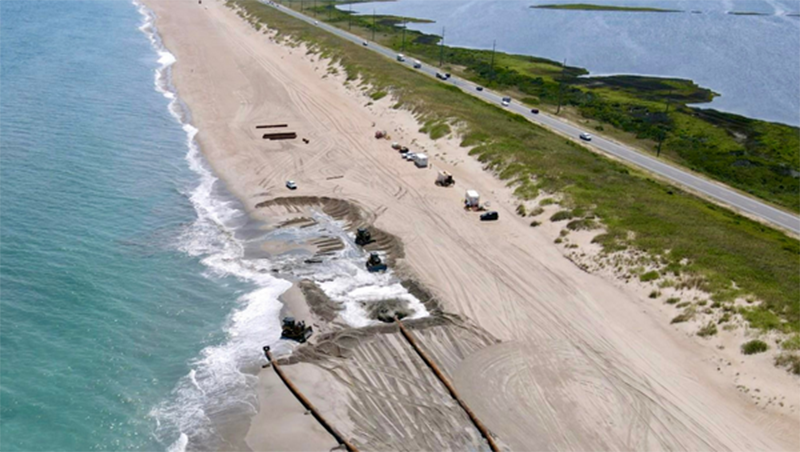Discussion continues for Kill Devil Hills dwelling regulations
Published 11:43 am Monday, October 28, 2024

- Kill Devil Hills Mayor John Windley expressed readiness to make changes to single-family home regulations. KDH video still
|
Getting your Trinity Audio player ready...
|
Kill Devil Hills commissioners continued to discuss options for regulating large single-family dwellings at their October 9 meeting.
The town’s leaders have expressed concern over the extra-large residences along the oceanfront, or Ocean Impact Residential Zone. Some homes have as many as 36 bedrooms. Residents have complained that these bulky structures block ocean views and breezes, pose safety hazards due to the lack of access for emergency vehicles, and clog up community beach access parking lots by using them for overflow parking areas.
During public comment, Julie Owens Robertson, owner of a historic cottage in Kill Devil Hills, approved of the new regulations the town was considering but said it was “too little, too late.”
“These structures are really not built for single families,” Robertson said. “They are special event houses and should be treated as such.”
In September, planning director Meredith Guns and assistant planning director Cameron Ray presented five options the town could use to limit the density and development of these large structures: limit stacked parking to no more than six vehicles; require one open and unobstructed access aisle; require 10% landscaping within the parking lot; increase setbacks for houses above a certain number of square feet; and designate large family dwellings as a special use, which would require more oversight.
Commissioners tasked the planning department to return to the board in October with examples of how the options would affect the oceanfront.
During the presentation, Guns showed pictures of large oceanfront homes in Kill Devil Hills and gave statistics about the home size, value and floor area ratio.
Floor area ratio is the heated square footage in proportion to lot size. For example, for a floor area ratio of .25, a 10,000 square foot lot would be allowed a home size of up to 2,500 square feet (10,000 x .25 = 2,500).
Part of the issue is that oceanfront lots in KDH can be quite large, as some of them have irregular shapes.
With floor area ratios in the .4s or .5s, one-acre lots can easily sustain homes that are almost 20,000 square feet. While there are not that many homes of this size in town, under current ordinances, property owners with modest-sized homes could legally tear down their homes and rebuild substantially larger ones.
From a financial standpoint, this is appealing to some property owners.
Tom Stewart, who works in property management, came to the meeting representing this perspective.
“We represent owners who have smaller homes and who have made investments and have made plans to one day potentially build a larger home or see something like that go in its place and they’re basing a lot of their decisions about that on the current value of that property. That property’s value is based on its ability to sustain a large home,” Stewart said.
“You’re looking at potentially knocking 30% of a property’s value just like that overnight,” he said, snapping his fingers. He held up the list of five potential changes suggested by the planning department. “And not by doing all of these things – any single one of these things could have an impact.”
At the October meeting, Guns presented the planning department’s recommendations to control bulk and density: to limit stacked parking, to require an access aisle, and to use a to-be-determined floor area ratio. The planning department recommended either .25, .3, or .35.
For a half-acre lot, therefore, at a .3 floor area ratio, the largest home allowed would be 6,534 square feet. “These are not going to be small homes. They are just going to be proportional,” Mayor Pro Tem Ivy Ingram said.
Ingram said that the recommended changes will help to address the density on the beach. She said that the large houses also clog up the beaches with tents and chairs.
“People over and over and time and time again tell me they come to the beach, they live in Kill Devil Hills, they work in Kill Devil Hills, and they go to the beach and they a can’t find a parking spot because these homes are overflowing into the accesses. And if they can find a parking spot they can’t find a place to sit because the beach is so dense,” Ingram said.
Commissioner Terry Gray asked the town attorney if this would create downzoning issues, and the attorney said it would not. The changes, if passed, would create nonconformities, which means that current homes would be considered “non-conforming” to new regulations. These homes would be allowed to rebuild in the same footprint in case of a fire or natural disaster, but could not increase the size of their homes.
The board was in agreement that large single-family homes need appropriate access aisles for safety, but were divided on the ideal floor area ratio. Commissioner BJ McAvoy was in favor of a higher floor area ratio.
“I’m more on property rights side,” McAvoy said. “What we do here is going to affect the value of [people’s] homes.”
Mayor John Windley was in favor of making changes. Citing the quality of life that those who own small cottages and live next to massive new developments, Windley said, “I think what we’re discussing tonight is a chance to kind of level that playing field to something that it was more in line to what people had in mind for our oceanfront 20 years ago. I think that’s a reset button that needs to be hit.”
Commissioners agreed to move the conversation onto the next phase.
SUBSCRIBE TO THE COASTLAND TIMES TODAY!





